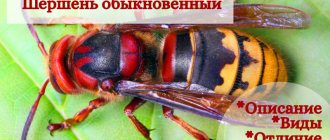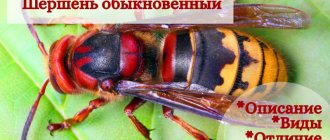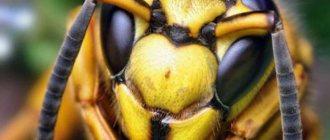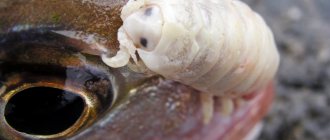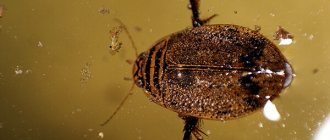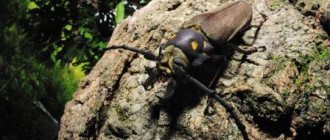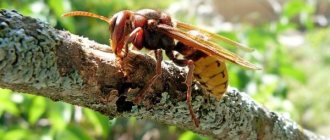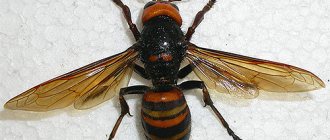On a warm May day you can see a large wasp buzzing as it goes about its business. This is a common hornet - a representative of the family of social wasps. Despite its impressive size, it is not aggressive. Vespa crabro or hornet wasp prefers to feed on fruit juice and other sweet foods. Insects live in large families with a constant hierarchy. The head of the colony is the queen - the only female capable of laying fertilized eggs. The purpose of working females and males is to serve the queen and the growing larvae.
Description of the hornet
Vespa crabro is a species of the largest wasp found in Europe. The body length of working individuals is 18-24 mm, the uterus is much larger - 25-35 mm. The appearance of females and males is almost identical, their differences are noticeable only with magnification. The number of segments in the antennae of the male is 13, and in the female 12, on the abdomen - 7 and 6, respectively. Small transparent wings fold along the back when at rest. The deep slit of the reddish-orange eyes resembles the letter "C". The surface of the body is densely covered with hairs.
Interesting fact. There are 9 subspecies of Vespa crabro in the world.
Area of residence
In the Northern Hemisphere, up to the 63rd parallel, the most common species is the common hornet. It can be found in Europe, North America, Kazakhstan, and Ukraine. In Russia, insects live over a vast territory from the European border to the Ural Mountains and Siberia. Even in the northern and eastern provinces of China they know what the European hornet looks like.
Interesting fact. Until the mid-19th century, hornet wasps were not found in North America. They were accidentally introduced by European sailors.
Differences between a hornet and a wasp
Hornets differ from other members of the family in size and enlarged nape. These parameters immediately catch your eye. The differences are also noticeable in the nuances of color - the back, base of the abdomen and antennae of the hornet are brown, while those of the wasp are black. The basic proportions of the body structure of insects are similar; they have a thin waist, strong jaws, and a sting.
External features complement the differences in character; despite its superior size, the common hornet is less aggressive than the wasp. An attack can be provoked by approaching the nest where the hornets live in the summer.
Information. A prejudiced attitude towards hornet wasps has developed due to their impressive size and menacing buzzing sound when flying. Unreasonable fear causes active actions towards insects; a person waving his hands at it will be bitten.
First aid
After a bite, the victim must be given first aid.
The following measures should be taken at home:
- Inspect the attack site. Usually the sting does not remain in the skin, but there is a risk that part of it may remain inside the wound. In this case, you need to try to remove it with tweezers. Squeezing is not recommended.
- Rinse the wound with clean running water. We recommend using antibacterial soap.
- An insect sting is characterized by the presence of pathogenic microorganisms. To disinfect the damaged area, use a cotton swab soaked in alcohol, carefully wiping the wound.
- Treatment of the bite site can be carried out using liquids containing acids as components. For example, lemon or onion juice.
- To reduce inflammation, applying something cold to the affected area can be helpful. Ice or chilled water in a plastic bag is suitable for this.
- Take an antihistamine, for example, Tavegil, Suprastin.
- After providing first aid, contact a specialist - this is not necessary if minor harm has been caused and no unpleasant consequences have arisen.
Types of hornets
There are more than two dozen varieties of hornets. Initially, insects were found only in East Asia. With the help of humans, typical inhabitants of the subtropics reached North America and Canada. In addition to the ordinary one, which is described above, it is worth considering three interesting and numerous types:
- The Asian giant hornet is the largest representative of wasps. It is not for nothing that in Taiwan they gave him the appropriate nickname - “tiger bee”. The body length reaches 60 mm, the wingspan is more than 75 mm. Its habitat: China, Korea, Japan, India, Primorsky Krai of the Russian Federation. The insect is known for its highly toxic poison, produced in large quantities. Its bite is dangerous and painful; an attack by several individuals leads to the death of a person. Japanese statistics report 40 annual deaths from the sting of the sparrow bee.
- The black hornet is similar in size to its ordinary European counterpart. It is distinguished by its black belly and brown wings. The insect is found in Transbaikalia and Primorye, as well as in India and China. An unusual fact about the development of the black hornet deserves attention. His queen deceives someone else's nest, masquerading as their queen with pheromones. The deceived family takes care of the eggs and larvae of the parasite.
- The eastern hornet is characterized by its adaptation to dry climates. The insect lives in the subtropics of Asia and America, and is widespread in southern Europe. The size of individuals is smaller than representatives of other species, the uterus reaches 30 mm, males are smaller - 16-20 mm.
Population and species status
Photo: Hornet animal
The genus of hornets is quite wide. It includes more than twenty different species of insects, differing in color, size, feeding habits and lifestyle. Due to the presence of several species and high fertility, this genus is not endangered and is not listed in the Red Book.
The general population of hornets does not cause concern among scientists. It is normal, causes the least concern, and has a low risk of extinction. However, if we consider the hornet wasp population in terms of individual species, the situation is not so encouraging. Many species are on the verge of extinction and are listed in the Red Books of individual states and cities. The reduction in the number of such animals is due to completely different reasons, which can be found out in the next section of the publication.
The common hornet is an endangered species. Its population in different regions of its natural habitat is very unstable. In particular, this variety is included in the Red Book of the Smolensk region. Also a small representative of the hornet genus is the Dybovsky hornet (black). It is of average size for hornets, has a black-brown color, and is a predator. The black hornet is included in the Red Book of the Chita region. Some species of hornets are included in the Red Books of Germany and many other European countries.
Life cycle features
To learn more about an insect, consider its life cycle from birth to death.
Birth
A single queen gives life to an entire generation of a family of giant wasps. In the spring she finds a place to build a house for a new colony. The female makes the first honeycombs herself, then lays eggs in them. After a few days, larvae appear and require animal food. Their mother regularly goes hunting for caterpillars, beetles, butterflies and other insects. The grown larvae wrap themselves in silk thread and turn into pupae. Two weeks later, the young hornets gnaw the path of their cocoon.
Interesting. In bad rainy weather, the hornets cannot fly out of the nest, then the larvae give droplets of food to the workers.
Maturity
In July, several working males and females grow up and are ready to take care of the family. They help complete the construction of honeycombs and fly for protein for the larvae. The queen stops leaving the house and concentrates on laying eggs. How long do hornets live? The life of working females and males is very short. They grow up at the end of summer, and in September most of the individuals die. The rest survive until the first cold weather.
In early autumn, the family reaches its population peak. In the last clutch, the queen laid fertilized eggs, from which females emerged that could become new queens. Individuals born earlier had altered ovaries; their functioning was suppressed by the queen’s pheromones. Young females and males begin to swarm around the nest and mate. The insects will save the sperm obtained in the fall to found a new family. After mating, males will live for about a week. The old queen loses her ability to reproduce and is driven out onto the street or killed.
Lifestyle
Insects create a colony. They are active at any time. Sleep time takes a few minutes. In case of danger, they begin to defend their swarm and queen. When feeling anxious, the queen releases an alarm pheromone - a special substance that activates other relatives to attack.
Its natural habitat is forest. Due to the active cutting down of trees, insects are looking for new places to live. For this reason, they can be found in the garden and in outbuildings. The fight against them is carried out when the population is small. Only specialists can handle a large colony.
Insects are inherently hierarchical. The head of the colony is the queen. She is the only female capable of laying fertilized eggs. Working females and males serve the queen and larvae. There can only be one uterus; when it is exhausted, a new one is found.
It is not recommended to make sudden movements or shake the nest. Also, you should not kill hornets near the hive, since a dying individual transmits an alarm signal and encourages an attack.
How do hornets winter?
Almost all members of the hornet colony die before the onset of winter. Only fertilized young females will remain. During the last warm days, they actively hunt, replenishing their body’s energy reserves. A decrease in daylight hours becomes a signal for the onset of diapause. This is a condition in which the body's metabolic processes are inhibited.
Where do hornets winter? They choose secluded places where they can hide from severe frosts and natural enemies - birds and mammals. Females prefer to climb under the bark of trees; the deeper they are, the greater their chances of surviving until spring. For wintering, tree hollows filled with fallen leaves, crevices in sheds, and attics are used. Females will wake up in May, when the average air temperature does not drop below 100. They will live the longest - 1 year and create a new family of common hornets.
Nutrition
Hornets can be called omnivorous insects; they are dexterous hunters, but at the same time lovers of plant food. What do hornets eat? Adults have a wide gastronomic diet:
- nectar;
- juice of ripe soft fruits (peach, pear, apple);
- berries - raspberries, blackberries, strawberries;
- aphid secretions;
- honey.
Predatory insects, except for the queen, eat their relatives only at the larval stage. Working individuals with enviable diligence shuttle between the nest and the hunting site, bringing spiders, centipedes, and worms to their offspring. Hornets cut up prey with powerful jaws, feeding protein to the growing larvae and queen, which requires strength to lay eggs. Large wasps often attack individual bees and hives. One large individual is capable of tearing apart up to 30 honey plants.
Interesting fact. Hornets do not have a long period of sleep; they are active at any time of the day. To rest, they simply freeze for a few minutes. Numerous hungry larvae, the number of which sometimes reaches up to 500, require a lot of food. A family of predatory insects is capable of destroying up to 0.5 kg of garden pests daily.
What does an insect eat?
Hornets feed on nectar and plant foods containing a lot of sugar. Insect preferences include ripe fruits, berries, flower nectar, honey and tree sap.
At the same time, hornets are predators. They hunt insects to feed their larvae. With the help of its sting and powerful jaws, the hornet easily copes with flies, horseflies, gadflies, bees, wasps, grasshoppers and locusts. It completely chews the prey and feeds it to the larvae.
Building a nest
The place for the hornets' nest should be secluded, protected from bad weather and drafts. In nature, these are tree hollows; a reduction in their number forces the queen to seek shelter close to human habitation. Sometimes females choose a nesting box, which soon becomes completely filled with tiers of honeycombs, requiring them to find a new location. Insects can simply hang a nest on a tree branch, hide it in a rock crevice, a steppe hole, or in the attic of a house or outbuilding.
If there is no rotten stump or other wood nearby, working individuals cause significant damage to young branches. With strong jaws they scrape off the bark, which they use to build a nest. Ash or birch wood is mixed with saliva and becomes the building material for the hexagonal honeycomb walls of the nest. Born architects can create real masterpieces.
The nest material resembles cardboard or corrugated paper. The expansion of the structure is carried out in tiers, from top to bottom. From the first leg, attached by the uterus, it will grow to 5-7 tiers. Honeycomb plates have up to 500 cells. The outside of the nest has the shape of a cocoon. The thickness of the protective walls is several centimeters. Interestingly, the color of the cocoon depends on the wood, the most common being brown. The shape of the nest changes depending on the stage of construction. Typically, insects flock to their home to rest at night. How many hornets are in the nest? Their number depends on the stage of development of the colony, favorable conditions, and abundance of food. The colony can number 300-400 individuals.
A large amount of remains of eaten insects, corpses of dead hornets, and other debris accumulate on the ground under the building. This landfill emits an unpleasant odor and becomes a source of parasite development. They can lead to the death of the colony.
Information. Despite the colossal efforts spent on building the nest, the insects will not settle in it next year. The young queens will find a new home.
Features of the attack - how dangerous
Hornets are especially aggressive when it is necessary to protect their own home. Initially, only one individual of the family can attack, but when bitten, a signal aroma is released, which attracts the entire swarm of the colony.
Note that wasp representatives will sting everyone who is nearby, even if they did not participate in the destruction of the hive. European representatives are characterized by a sting length of 3 millimeters, but the most dangerous Asian individuals are 6 millimeters.
We can conclude that the level of aggressiveness of these insects is a rather controversial point, since in the absence of any action in their direction, namely destruction of the nest, hitting or killing an individual, they will not attack.
In case of danger, representatives of the wasp family will try to hide, and only in the absence of such an opportunity will they take a defensive position. Most often, small individuals will sting, since adult individuals are characterized by a more peaceful character.
How does a hornet bite?
The insect has a sharp and smooth sting that stings quickly and painfully. The insect's venom is not more toxic than that of a bee, and therefore the symptoms of intoxication are similar. The consequences of a bite depend on the body's reaction. Even with strong immunity, swelling and redness appear at the puncture site. If an individual manages to inject a large amount of poison by inflicting several sting strikes, inflammation occurs. With increased sensitivity to the toxin, anaphylactic shock occurs. In this case, urgent hospitalization is required.
Why does a severe allergic reaction occur? It is caused by histamine, a substance present in the chemical formula of the poison. Histamine accelerates the allergic effect, so even with a strong immune system, malaise appears. In Russia, death from the bites of the common hornet has been recorded only a few times in the history of observations. The largest number of deaths occur due to giant hornets in Asia.
The sting for hornets is a weapon of defense. It is a modified ovipositor connected to a gland that produces a toxin. The absence of notches makes it easy to remove the weapon from the wound. The introduction of poison occurs through muscle contraction. How does a hornet sting? It pierces the enemy's skin and injects a drop of toxin. The presence of a substance that acts on nerve endings causes instant pain. At the time of the bite, the insect does not use up its entire supply of poison. Otherwise, it will remain unarmed during the next attack. It takes some time for the poison to recover.
Attention. Bites in the neck area of the mouth are especially dangerous; they cause swelling of the larynx and block breathing. Due to immature immunity, children are at greater risk than adults.
For hunting, insects use their jaws, tearing prey with them. The production of potent poison and a long, strong sting indicate that they often have to repel enemy attacks on the nest.
Benefits and harms
Hornets are useful in that they destroy insects, making it easier for gardeners to combat garden pests, but the hornets' usefulness ends when they settle in apiaries.
Hornets - the storm of bees
In autumn, honey bees become the main food of hornets - other insects already die at this time.
When raiding hives, one hornet can eat about 30 bees in a day.
When uninvited guests appear, beekeepers try to get rid of them by all possible means.
Being too close to hornets can also be dangerous for humans. An insect bite causes burning pain and can provoke severe allergic reactions.
The bite can be dangerous to humans
Consequences
When attacking, a hornet can bite one or more times. A single bite is not as dangerous to humans as multiple bites. Getting large amounts of insect venom under your skin can cause serious problems.
After a hornet attack, a person experiences body intoxication , which leads to the following consequences:
- dizziness, headache, signs of nausea and vomiting.
- fever and chills, sweating.
- difficulty breathing, shortness of breath, in rare cases, convulsions.
The consequences may vary in severity. It depends on the type of hornet, on the person’s immune system, on his age and sensitivity to allergens. Children are the most susceptible to hornet venom. The most dangerous consequence of a hornet attack can be Quincke's edema and anaphylactic shock.
Help with a bite
There are several first aid rules for a hornet sting that will help minimize the consequences of an attack by the largest wasp. The sequence of actions is as follows:
- Examine the bite site and remove sting particles with tweezers, if any.
- Carefully squeeze out the insect venom.
- Wash the wound with soap and then wipe it with a solution of alcohol or potassium permanganate.
- Apply cold.
- Take an antihistamine.
You don’t need to visit a doctor if the hornet has bitten you only once and there is no deterioration in the victim’s condition. However, you should consult a doctor if the following signs are present:
- severe pain and extensive swelling of the bite site;
- weakness and severe manifestations of allergies;
- attack by several hornets at the same time;
- The victim's age is under 16 years.
Burrowing wasps are very caring parents. Paper wasps are named so because of the way they build their nests. A complete description of the insect can be found here.
A road wasp sting can be quite dangerous, especially if a person has allergies. What to do if you are bitten, read the article at this link.
How to Avoid a Bite
The hornet attacks only when it senses danger to itself or its nest. At the first threat, it releases a special substance - alarm pheromone , which serves as an attack signal for other individuals. Therefore, you should not kill the hornet near the nest. Hornets,
sensing the smell of danger, the whole family can attack the offender of their relative.
It is advisable to destroy hornet nests only in cases where they threaten bees or their nests are located too close to housing. If the insects have built their home where they will not be disturbed, there is no need to be afraid of their attack. On the contrary, they will even become assistants in protecting the crop from other insects.
Of course, the hornet can be dangerous to humans. However, you can coexist peacefully with it, if you take into account its habits and characteristics. It is also better not to come close to it and not disturb its nest. And it is important to remember that in nature there is nothing superfluous, which means it is better to protect hornets rather than destroy them.
Danger to humans - myth or reality?
The behavior of the common hornet differs significantly depending on the distance from the nest. During flights for food for themselves, the queen and larvae, they behave peacefully. But, when a real or imaginary danger to the nest appears, the hornets mercilessly sting everyone who falls into the zone of their aggression. There are always several individuals on duty near the house for protection. In the event of an attack, they give a special alarm signal that gathers the whole family.
How dangerous are hornets to humans? The strong venom of insects when bitten causes an attack of pain. Unpleasant sensations and swelling may persist for several days. The symptoms are similar for all victims, only the intensity of the manifestation differs.
Insects jealously defend their nest, but with careful approach, you can monitor the life of the colony. The main thing is to remember a few rules of behavior:
- do not make sudden movements;
- do not touch the nest with your hands or a stick;
- do not interfere with the flight of the hornets.
It is recommended to destroy the nests of the common hornet only if there is an increased danger in the neighborhood. For example, if it is located in a used room or next to an apiary. Predators are the worst enemies of bees and beekeepers. People with hypersensitivity to poison should get rid of the neighborhood, otherwise they will be in danger. In general, large wasps are peaceful neighbors, which will also help with the destruction of pests.
Bite symptoms
The hornet does not leave a sting when it bites, so it can sting several times. This feature distinguishes it from bees. A large number of bites can be fatal to humans. Especially if you are allergic to wasp venom.
Symptoms that develop from a hornet bite:
- sharp, severe pain;
- swelling, redness;
- itching, burning at the bite site;
- increase in body temperature to high numbers;
- possibly manifestations of allergic reactions, including anaphylactic shock.
